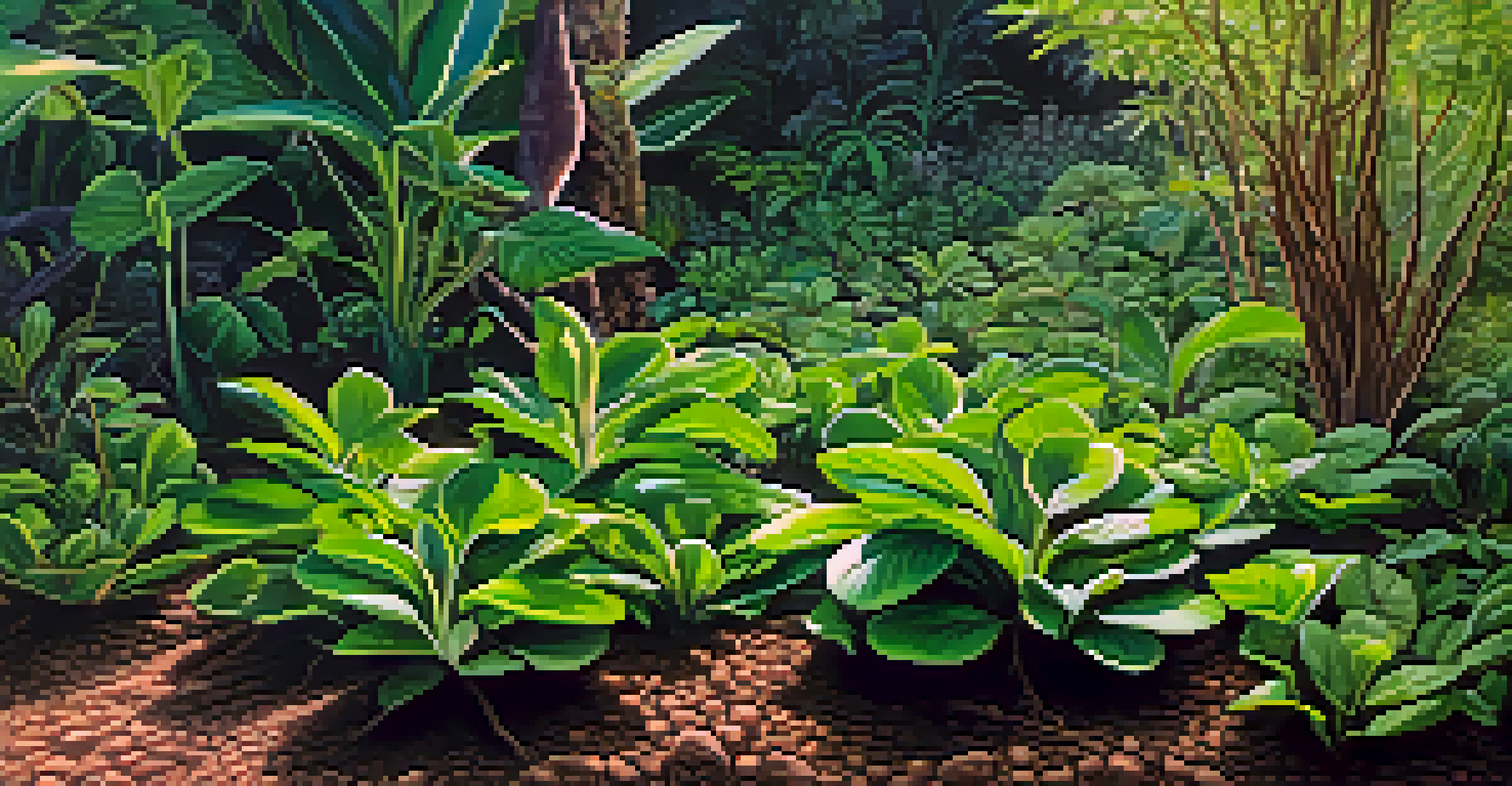The Role of Permaculture in Ayahuasca Cultivation Practices

Understanding Ayahuasca and Its Cultural Significance
Ayahuasca is a traditional Amazonian brew, celebrated for its spiritual and healing properties. It combines two primary plants: the Banisteriopsis caapi vine and the leaves of the Psychotria viridis shrub. Used in shamanic ceremonies, ayahuasca promotes deep introspection and connection to nature, making it a vital part of indigenous cultures. Acknowledging its cultural roots is essential as we explore modern cultivation practices.
The clearest way into the Universe is through a forest wilderness.
Beyond its spiritual aspects, ayahuasca has gained attention in Western wellness circles, often associated with therapeutic benefits for mental health. This increasing interest has led to a rise in demand, prompting more growers to enter the field. However, this surge also raises questions about sustainability and the impact on traditional practices. Balancing respect for indigenous knowledge with modern agricultural methods is crucial.
As ayahuasca's popularity grows, understanding its cultural significance helps ensure that cultivation practices honor the traditions from which they arise. This respect for heritage is a key element as we delve deeper into how permaculture can play a role in sustainable cultivation.
What is Permaculture and Its Core Principles?
Permaculture is an agricultural philosophy that emphasizes sustainable land use through a design system inspired by natural ecosystems. It revolves around the idea of working with nature rather than against it, promoting biodiversity, and creating self-sustaining environments. By using techniques like companion planting and crop rotation, permaculture aims to mimic the resilience found in natural ecosystems.

The core principles of permaculture include observing and interacting with nature, using renewable resources, and valuing diversity. These principles not only enhance soil health but also encourage a variety of plant species to thrive together. This is particularly important for ayahuasca cultivation, as it requires a delicate balance of environmental factors to flourish.
Ayahuasca's Cultural Importance
Understanding ayahuasca's significance in indigenous cultures is essential for sustainable cultivation practices.
By integrating permaculture practices, growers can create a more harmonious relationship with their land. This approach not only benefits the plants but also fosters a healthier ecosystem overall, paving the way for sustainable ayahuasca production.
The Intersection of Permaculture and Ayahuasca Cultivation
Permaculture and ayahuasca cultivation intersect at the point of sustainability, as both prioritize harmony with nature. By applying permaculture principles to ayahuasca farming, cultivators can enhance biodiversity, improve soil health, and reduce reliance on chemical inputs. This synergy is not just beneficial for the plants but also for the surrounding environment and local communities.
The greatest threat to our planet is the belief that someone else will save it.
For instance, companion planting—growing different plants in proximity to benefit each other—can be particularly effective. By intermingling ayahuasca plants with other species, growers can naturally deter pests and improve nutrient availability. This method aligns with the ethos of permaculture, promoting a self-sufficient ecosystem that thrives on mutual support.
Moreover, integrating permaculture practices can help mitigate the environmental impact of increased demand for ayahuasca. As cultivators embrace regenerative methods, they can ensure that their practices contribute positively to both the land and the communities that depend on it.
Benefits of Permaculture for Ayahuasca Growers
Adopting permaculture techniques offers numerous benefits for ayahuasca growers, including increased resilience to climate change. By fostering biodiversity and enhancing soil health, permaculture creates ecosystems that can better withstand environmental stresses. This is crucial in regions where climate fluctuations could threaten traditional cultivation methods.
Additionally, permaculture practices can lead to higher yields and improved quality of ayahuasca plants. Healthy ecosystems promote robust plant growth, which is essential for maintaining the potency and effectiveness of the brew. As growers focus on sustainability, they also cultivate a product that aligns with the growing consumer demand for ethically sourced ingredients.
Permaculture Enhances Sustainability
Integrating permaculture principles into ayahuasca farming promotes biodiversity and reduces environmental impact.
Furthermore, permaculture encourages a sense of community among growers. By sharing knowledge and resources, farmers can learn from one another, creating a network of support that fosters innovation and sustainability in ayahuasca cultivation.
Challenges in Implementing Permaculture Practices
While the benefits of permaculture for ayahuasca cultivation are compelling, challenges do exist. Transitioning from conventional farming methods to permaculture can require significant time, effort, and investment. This shift may seem daunting for growers accustomed to traditional practices, especially when immediate results are desired.
Moreover, knowledge gaps can pose hurdles for growers unfamiliar with permaculture principles. Accessing education and resources may be limited, particularly in remote areas where ayahuasca is traditionally cultivated. Bridging this gap is essential for empowering farmers with the skills they need to implement sustainable practices effectively.
Lastly, market pressures can complicate the adoption of permaculture. As demand for ayahuasca increases, some growers might prioritize quantity over quality. Balancing the need for production with the principles of sustainability can be a delicate dance, but one that is vital for the future of ayahuasca cultivation.
Case Studies: Successful Permaculture Ayahuasca Farms
Several farms around the world have successfully integrated permaculture into their ayahuasca cultivation practices, showcasing the potential of this approach. For example, a farm in Peru has adopted a multi-crop system, where ayahuasca is grown alongside other medicinal plants. This method not only enhances biodiversity but also creates a more resilient ecosystem that supports various plant species.
Another inspiring case is a cooperative in Brazil that focuses on community-based permaculture practices. By sharing resources and knowledge, this group of growers has seen improvements in both crop yields and soil health. Their success serves as a testament to the power of collaboration and the importance of community in sustainable agriculture.
Community Supports Sustainable Growth
Collaborative efforts among growers foster knowledge sharing, leading to improved sustainability in ayahuasca cultivation.
These case studies highlight that permaculture is not just a theoretical concept but a practical solution for enhancing ayahuasca cultivation. As more growers embrace these methods, we can anticipate a positive shift towards sustainability in the industry.
The Future of Ayahuasca Cultivation with Permaculture
Looking ahead, the future of ayahuasca cultivation lies in the hands of those who embrace permaculture principles. As awareness of sustainability grows, both consumers and growers are increasingly recognizing the importance of ethical sourcing. This shift towards responsible practices can lead to a more sustainable and respectful approach to ayahuasca farming.
Moreover, integrating permaculture can inspire innovation in cultivation techniques, leading to new ways of growing ayahuasca that are more environmentally friendly. As more growers share their experiences and successes, a collective knowledge base can emerge, further advancing sustainable practices in the industry.

Ultimately, the role of permaculture in ayahuasca cultivation is about fostering a deeper connection to the land and respecting the traditions that have shaped this powerful brew. By prioritizing sustainability, we can ensure that ayahuasca continues to thrive for generations to come, benefiting both people and the planet.